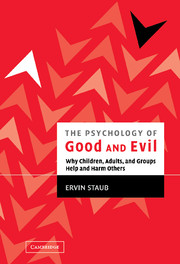Book contents
- Frontmatter
- Contents
- Preface
- Acknowledgments
- PART I INTRODUCTION AND CORE CONCEPTS
- 1 Good and Evil: Themes and Overview
- 2 Studying the Pivotal Role of Bystanders
- 3 Studying and Promoting Altruism and Studying and Working to Prevent Genocide: The Guiding Role of Early Survival
- 4 Is Evil a Useful Concept for Psychologists and Others?
- 5 Basic Human Needs and Their Role in Altruism and Aggression
- PART II THE ROOTS OF HELPING OTHER PEOPLE IN NEED IN CONTRAST TO PASSIVITY
- PART III HOW CHILDREN BECOME CARING AND HELPFUL RATHER THAN HOSTILE AND AGGRESSIVE
- PART IV THE ORIGINS OF GENOCIDE, MASS KILLING, AND OTHER COLLECTIVE VIOLENCE
- PART V THE AFTERMATH OF MASS VIOLENCE: TRAUMA, HEALING, PREVENTION, AND RECONCILIATION
- PART VI CREATING CARING, MORALLY INCLUSIVE, PEACEFUL SOCIETIES
- Appendix: What Are Your Values and Goals?
- Index
1 - Good and Evil: Themes and Overview
Published online by Cambridge University Press: 07 May 2010
- Frontmatter
- Contents
- Preface
- Acknowledgments
- PART I INTRODUCTION AND CORE CONCEPTS
- 1 Good and Evil: Themes and Overview
- 2 Studying the Pivotal Role of Bystanders
- 3 Studying and Promoting Altruism and Studying and Working to Prevent Genocide: The Guiding Role of Early Survival
- 4 Is Evil a Useful Concept for Psychologists and Others?
- 5 Basic Human Needs and Their Role in Altruism and Aggression
- PART II THE ROOTS OF HELPING OTHER PEOPLE IN NEED IN CONTRAST TO PASSIVITY
- PART III HOW CHILDREN BECOME CARING AND HELPFUL RATHER THAN HOSTILE AND AGGRESSIVE
- PART IV THE ORIGINS OF GENOCIDE, MASS KILLING, AND OTHER COLLECTIVE VIOLENCE
- PART V THE AFTERMATH OF MASS VIOLENCE: TRAUMA, HEALING, PREVENTION, AND RECONCILIATION
- PART VI CREATING CARING, MORALLY INCLUSIVE, PEACEFUL SOCIETIES
- Appendix: What Are Your Values and Goals?
- Index
Summary
This book is about understanding the roots of children, adults, and groups of people helping and harming others. It is about ways to create more caring for others' welfare and less harmful, aggressive, violent behavior. It is about how children, adults, small groups, and nations can become “active bystanders” who respond to others' suffering and help those in need, rather than remaining passive observers, even closing their eyes and hearts to others' fate.
There is much goodness in the world. A mother paying loving attention to a child. A father taking time off work to take his child to the first day of kindergarten – an act that saved the life of the president of a major bond-trading firm at the time of the terrorist attack on the World Trade Center. A grown son taking care of a sick old father. A popular girl spending time with a new, somewhat awkward girl in class, saving her from unkind behavior by classmates. A young Canadian boy, Craig Kielberger, hearing about child labor and with the help of an older brother and parents creating an international organization, of children and led by children with the help of adults, to eliminate child labor, to protect children, to promote their welfare. Another child, seeing homeless people on the streets, organizing a movement to bring blankets to homeless people.
- Type
- Chapter
- Information
- The Psychology of Good and EvilWhy Children, Adults, and Groups Help and Harm Others, pp. 3 - 25Publisher: Cambridge University PressPrint publication year: 2003
- 1
- Cited by



